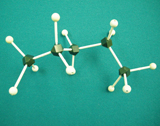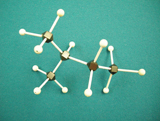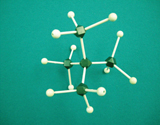Module 5
1. Module 5
1.8. Page 2
Module 5—Hydrocarbons and the Petroleum Industry
 Explore
Explore
 Read
Read
Read pages 362–363 in the textbook to learn more about natural gas, including its composition and refinement.
 Self-Check
Self-Check
There are six main steps in the natural gas refining process:
-
Water and liquid hydrocarbons are removed from the gas.
-
Hydrogen sulfide gas is removed through a reaction with an amine.
-
Hydrogen sulfide gas reacts with oxygen to make sulphur dioxide.
-
The remaining hydrogen sulfide and sulphur dioxide are further recovered to make blocks of sulphur.
-
The remaining parts are cooled under high pressure to condense all components except methane.
-
The condensed liquid is distilled to further separate the components.
SC 1. Prepare a table showing which of these steps involve chemical reactions and which involve physical changes.
 Self-Check Answers
Self-Check Answers
Contact your teacher if your answers vary significantly from the answers provided here.
SC 1.
| Chemical Reaction | Physical (Phase) Change |
|---|---|
steps 2, 3, 4 |
steps 1, 5, 6 |
 Read
Read
“Table 1” on page 363 of the textbook lists six hydrocarbon components of natural gas. The main components are methane, propane, ethane, and pentane. What is similar about these molecules?
Read pages 366–367 in the textbook.
The components of natural gas all end in “ane” and are considered alkanes. As hydrocarbons, alkanes are composed of only hydrogen and carbon.
Methane, ethane, propane, and butane represent the simpler alkane molecules. Regardless of the number of carbon atoms, an alkane will always have single bonds between all carbon atoms. The remaining bonds that carbon atoms can make are to hydrogen atoms.
You will recall from your work in Chemistry 20 that carbon atoms have four bonds to other atoms. For alkanes, each carbon will be chemically bonded to four other atoms, either carbon or hydrogen.
 Try This
Try This
Molecular Models of C5H12
How many different forms can a molecule with the formula C5H12 have? Use materials you find at home or at school to construct a molecular model of each of the different forms you identify. Recall the following information when constructing your representations of hydrocarbons:
- Carbon atoms can bond with up to four other atoms.
- Hydrogen atoms can only bond with one other atom.
- In alkanes, only one bond exists between two adjacent carbon atoms.
- The general chemical formula for an alkane is CnH2n + 2.
TR 1. Use a digital camera to take a picture of each of the models you constructed. If you do not have a digital camera, sketch your drawings digitally (using a program on your computer) or by hand.
TR 2. Summarize your work in a table. The table should have a column for each of the molecular models you constructed and a row for the pictures you took. Paste your pictures or sketches in your table. Later in this lesson, you will add rows to the table as you re–examine the molecules you constructed.
TR 3. Explain the principle underlying information points 1 and 2 above.
Save your work in your course folder.
 Read
Read
Methane, ethane, propane, and butane represent the simpler, linear alkane molecules. In TR 1–3 you probably noticed that the molecules you constructed had either linear appearances—all carbons connected to form a continuous chain, or branched appearances—one or more carbon atoms bonded to only a single carbon along the continuous chain.
Read pages 367–368 in the textbook to learn more about branched hydrocarbons. Complete “Sample problem 9.1” and “Communication example 1” on pages 368–369 of the textbook. In Module 6 you will learn that hydrocarbons with branches can be manufactured.
 Self-Check
Self-Check
SC 2. Retrieve a copy of the table you started in TR 2. Add a row with the heading “Systematic Name.” Use the information listed on page 368 of the textbook to write the name for each of the molecules represented in your table. Save a copy of your table in your course folder.
 Self-Check Answers
Self-Check Answers
Contact your teacher if your answers vary significantly from the answers provided here.
SC 2.
|
Forms of C5H12 |
||
1 |
2 |
3 |
|
Picture |
|
|
|
Systematic Name |
pentane |
2 –methylbutane |
2,2 –dimethylpropane |
structural isomers: compounds that share the same chemical formula but have different chemical structures
alkyl branch: a group of carbon and hydrogen atoms joined by single bonds
The group is not part of the main structure of a hydrocarbon.
The different forms of C5H12 you constructed and named in TR 1–3 and SC 2 are examples of structural isomers.
The ability of a carbon atom to have up to four bonds creates the possibility of branching along the length of a hydrocarbon molecule. An alkyl branch is not part of the main chain and contains only carbon and hydrogen. Even though they have the same molecular formula, each structure is considered a different entity. Not only do the isomers have different names, but often they have differences in their properties, which can allow them to have different uses.


